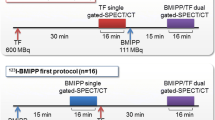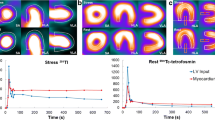Abstract
Background
Tetrofosmin gated single photon emission computed tomography (SPECT) allows simultaneous assessment of regional myocardial perfusion, global and regional left ventricular function, and function at rest and during pharmacologic intervention. SPECT with fatty acid analogues, such as β-methyl-iodophenyl-pentadecanoic acid (BMIPP), can be used to monitor metabolic changes induced by myocardial ischemia. In this work, the results of both studies obtained in patients with recent myocardial infarction are integrated.
Methods
Twenty patients underwent tetrofosmin and BMIPP scintigraphy with a 3-head camera. Two consecutive tetrofosmin gated SPECT acquisitions were performed 60 minutes after administration of technetium-99m tetrofosmin (925 MBq) at rest (3×20 stops of 9 s; matrix 64×64 over 360°. One acquisition was made at rest, and the second was made during dobutamine infusion (10 μg/kg/min). Regional functional abnormalities were quantified and expressed as wall thickening severity (WTsev) in arbitrary units. Left ventricular ejection fraction and volumes were assessed with the Cedars Sinai algorithm. BMIPP imaging started 20 minutes after iodine 123-BMIPP (150 MBq) administration at rest (3×32 stops of 60 s; matrix 64×64 over 360°; medium energy collimators). Tracer uptake was scored according to a 25-segment model.
Results
Sixteen of 18 patients had regional functional abnormalities at baseline (average WTsev 13.7 units). The WTsev score at baseline correlated well with the degree of residual perfusion. During dobutamine infusion, WTsev did not change (from 23.4 to 23.6 units) in 5 patients; it decreased (from 16.1 to 5.9 units) in 11 patients; and it increased (from 13.0 to 22.3 units) in 3 patients. An increase or decrease in WTsev during dobutamine infusion was associated with the presence of a considerable amount of BMIPP mismatched myocardium, whereas no change in WTsev was preferentially associated with a BMIPP matched pattern and perfusion defects with a higher severity score.
Conclusion
Immediately after infarction, the severity of regional dysfunction at rest correlated well with the perfusion defect severity. Improvement in regional function during dobutamine administration is associated with less severe perfusion defects and a considerable amount of BMIPP mismatched myocardium, both suggesting viability.
Similar content being viewed by others
References
Bonow R. Identification of viable myocardium. Circulation 1996;94:2674–80.
Opie LH, Hesse B. Radionuclide tracers in the evaluation of resting myocardial ischaemia and viability. Eur J Nucl Med 1997;24:1183–93.
Pierard LA, Landsheere CM, Berthe C, et al. Identification of viable myocardium by echocardiography during dobutamine infusion in patients with myocardial infarction after thrombolytic therapy, comparison with positron emission tomography. J Am Coll Cardiol 1990;15:1021–31.
Smart SC, Sawada S, Ryan Th, et al. Low dose dobutamine echocardiography detects reversible dysfunction after thrombolytic therapy of acute myocardial infarction. Circulation 1993;88:405–15.
Hawman PC, Haines EJ. The Cardiofocal collimator: a variable-focus collimator for cardiac SPET. Phys Med Biol 1994;39:439–50.
Everaert H, Vanhove C, Hamill JJ, et al. Cardiofocal collimators for gated single-photon emission tomographic myocardial perfusion imaging. Eur J Nucl Med 1998;25:3–7.
Franken PR, DeGeeter F, Dendale P, et al. Abnormal free fatty acid uptake in subacute myocardial infarction after coronary thrombolysis: correlation with wall motion and inotropic reserve. J Nucl Med 1994;35:1758–65.
Franken PR, Dendale P, DeGeeter F, et al. Prediction of functional outcome after myocardial infarction using BMIPP and sestamibi scintigraphy. J Nucl Med 1996;37:718–22.
Everaert H, Vanhove C, Schoors D, et al. Quantitative assessment of regional dysfunction from gated single-photon emission tomography myocardial perfusion studies: a non-segmental approach. Nucl Med Commun 1999;20:335–43.
Germano G, Kiat H, Kavanagh P, et al. Automatic quantification of ejection fraction from gated myocardial perfusion SPECT. J Nucl Med 1995;36:2138–47.
Mertens J, Eersels J, Vanryckeghem W. New high yield Cu(1) assisted 123I radioiodination of 15 (p-1-phenyl)-9-methyl pentadecanoic acid, a potential myocardial tracer. Eur J Nucl Med 1987;13:159–60.
DeGeeter F, Franken PR, Defrise M, et al. Optimal colimator choice for sequential iodine-123 and technetium-99m imaging. Eur J Nucl Med 1996;23:768–74.
Chua T, Kiat H, Germano G, et al. Gated technetium-99m sestamibi for simultaneous assessment of myocardial perfusion postexercise regional ventricular function and myocardial viability. Correlation with echocardiography and rest thallium-201 scintigraphy. J Am Coll Cardiol 1994;23:1107–14.
Tischler MD, Niggel JB, Battle RW, Fairnbank JT, Brown KA. Validation of global and segmental left ventricular contractile function using gated planar technetium-99m sestamibi myocardial perfusion imaging. J Am Coll Cardiol 1994;23:141–5.
Anagnostopoulos C, Gunning MG, Pennel DJ, Laney R, Proukakis H, Underwood SR. Regional myocardial motion and thickening assessed at rest by ECG-gated 99mTc-MIBI emission tomography and by magnetic resonance imaging. Eur J Nucl Med 1996;23:909–16.
Stollfuss JC, Haas F, Matsunari I, et al. Regional myocardial wall thickening and global ejection fraction in patients with low angiographic left ventricular ejection fraction assessed by visual and quantitative resting ECG-gated 99mTc-tetrofosmin single-photon emission tomography and magnetic resonance imaging. Eur J Nucl Med 1998;25:522–30.
Gunning MG, Anagnostopoulos C, Davies G, Forbat SA, Ell PJ, Underwood R. Gated technetium-99m-tetrofosmin SPECT and cine MRI to assess the ventricular contraction. J Nucl Med 1997;38:39–442.
Everaert H, Vanhove C, Franken RR. Effects of low-dose dobutamine on left ventricular function in normal subjects as assessed by gated single-photon emission tomography myocardial perfusion studies. Submitted to Eur J Nucl Med.
Tamaki N, Kawamoto M, Yonekura Y, et al. Regional metabolic abnormality in relation to perfusion and wall motion in patients with myocardial infraction: assessment with emission tomography using an iodinated branched fatty acid analogue. J Nucl Med 1992;33:659–67.
DeGeeter F, Franken PR, Knapp RR Jr, et al. Relationship between blood flow and fatty acid metabolism in subacute myocardial infarction: a study by means of 99mTc-MIBI and 123I-beta-methyl iodophenyl pentadecanoic acid. Eur J Nucl Med 1994;21:283–91.
Arnese M, Cornel JH, Salustri A, et al. Prediction of improvement in regional left ventricular function after surgical revascularization. A comparison of low dose dobutamine echocardiography with 201Tl single-photon emission computed tomography. Circulation 1995; 91:2748–52.
Panza JA, Dilsizian V, Laurienzo JM, Curici RV, Katsiyiannis PT. Relation between thallium uptake and contractile response to dobutamine. Implications regarding myocardial viability in patients with chronic coronary artery disease and left ventricular dysfunction. Circulation 1995;91:990–8.
Melon PG, de Landsheere CM, Degueldre C, Peters JL, Kulbertus HE, Pierard LA. Relation between contractile reserve and positron emission tomographic patterns of perfusion and glucose utilization in chronic ischemic left ventricular dysfunction: implications for identification of myocardial viability. J Am Coll Cardiol 1997;30:1651–9.
Kitsiou AN, Srinivasan G, Quyyumi AA, Summers RM, Bacharach SL, Dilsizian V. Stress-induced reversible and mild-to-moderate irreversible thallium defects: are they equally accurate for predicting functional recovery of regional left ventricular function after revascularization? Circulation 1998;98:501–8.
Author information
Authors and Affiliations
Corresponding author
Rights and permissions
About this article
Cite this article
Everaert, H., Vanhove, C. & Franken, P.R. Assessment of perfusion, function, and myocardial metabolism after infarction with a combination of low-dose dobutamine tetrofosmin gated SPECT perfusion scintigraphy and BMIPP SPECT imaging. J Nucl Cardiol 7, 29–36 (2000). https://doi.org/10.1067/mnc.2000.103135
Received:
Accepted:
Issue Date:
DOI: https://doi.org/10.1067/mnc.2000.103135




